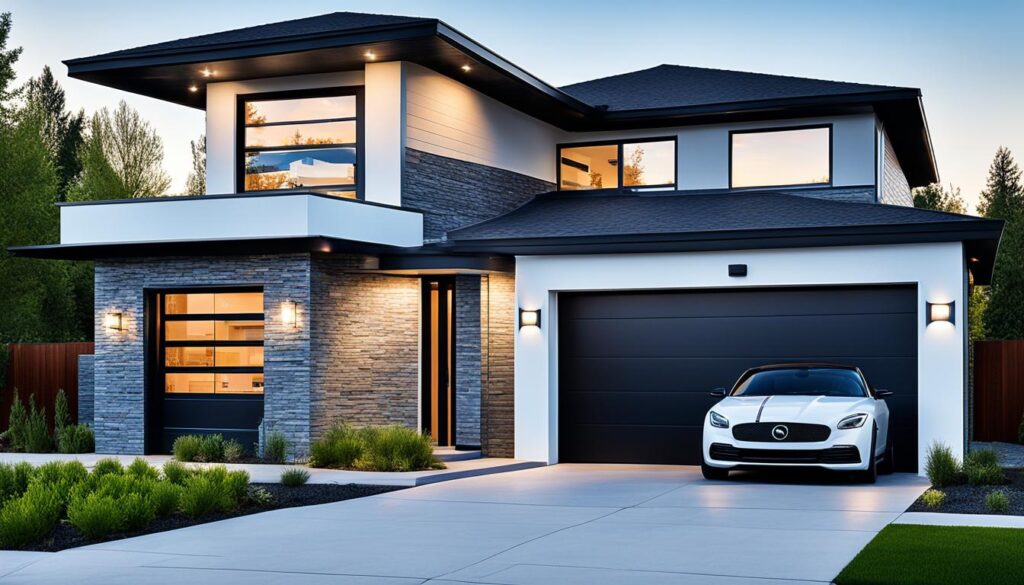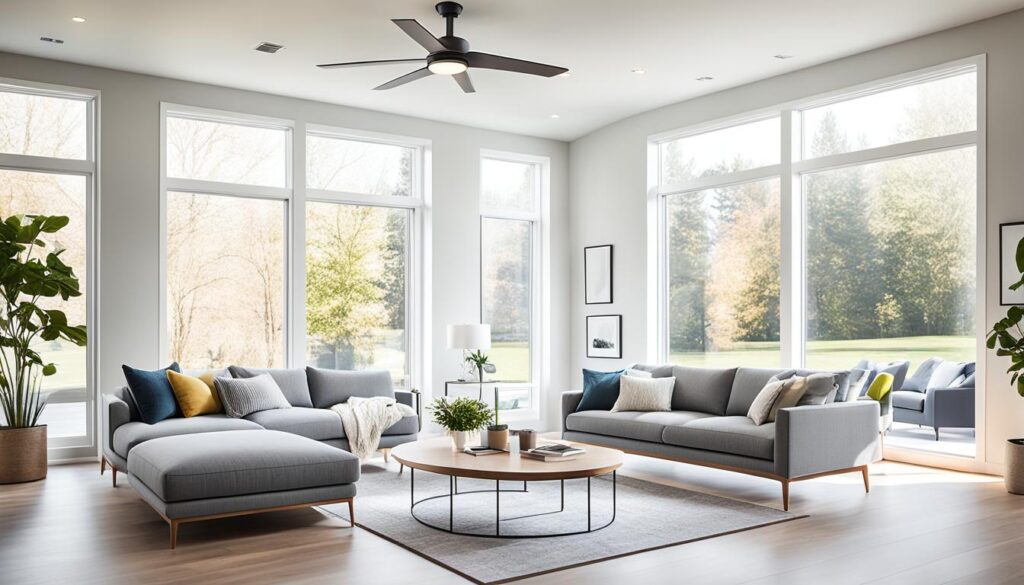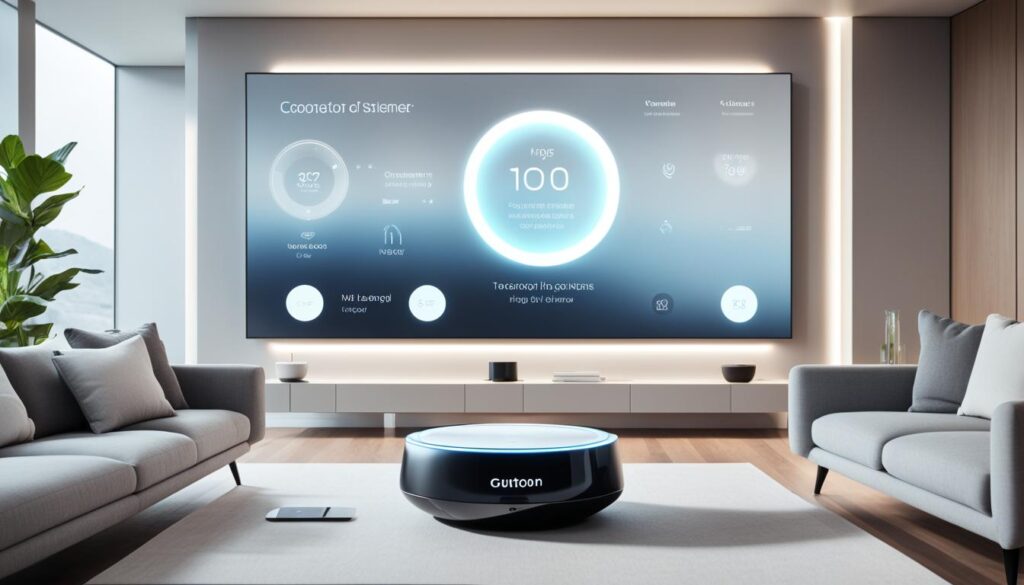Welcome to our comprehensive guide to smart home technology in 2024. As technology continues to advance, our homes are becoming smarter and more connected than ever before. In this article, we will explore the essential aspects of smart home technology and provide expert tips on optimizing your connected living space.
Key Takeaways:
- Understand the basics of smart home technology and how it can enhance your everyday life.
- Learn about the key components of a smart home system and how they work together seamlessly.
- Explore the various security features offered by smart home technology to keep your home and loved ones safe.
- Discover how smart devices can automate your home and simplify your daily routines.
- Find out how smart home technology can contribute to energy efficiency and create a greener living space.
Understanding Smart Home Technology
Before delving into the details, it’s important to have a clear understanding of what smart home technology entails. In this section, we will discuss the basics of smart home devices, their capabilities, and how they can enhance your everyday life.
Smart home technology refers to the integration of internet-connected devices and systems that allow you to control various aspects of your home remotely. These devices, often referred to as Internet of Things (IoT) devices, are designed to make your home more efficient, comfortable, and secure.
With smart home technology, you can automate tasks such as adjusting the thermostat, turning on lights, or even feeding your pets while you’re away. These devices are equipped with sensors, Wi-Fi connectivity, and advanced algorithms that enable them to interact with each other and with you through a central hub or smartphone app.
One of the key benefits of smart home technology is its ability to enhance convenience. Imagine being able to control your home’s lighting, heating, and security systems with just a few taps on your smartphone or a simple voice command to your virtual assistant.
Smart home devices are not only convenient but also offer advanced functionalities. From learning your preferences and adapting to your routines to providing real-time alerts and notifications, these devices have the potential to transform the way you interact with your home.
Smart home technology is more than just a trend – it’s a revolution in the way we live and interact with our living spaces. By embracing and understanding this technology, you can unlock a whole new world of possibilities that will enhance your everyday life.
Whether you’re a tech enthusiast or a novice, understanding the basics of smart home technology is the first step towards creating a connected living space that suits your needs and preferences. In the upcoming sections, we will delve deeper into the various components, features, and benefits of smart home technology.
Before we proceed, let’s take a moment to visualize how smart home technology fits into the overall ecosystem of connected devices:
| Connected Devices | Technology |
|---|---|
| Smart thermostats | Temperature control |
| Smart speakers | Voice command recognition |
| Smart door locks | Security |
| Smart cameras | Surveillance |
| Smart lighting | Light control |
Key Components of a Smart Home System
When it comes to building a smart home system, understanding the key components is essential. These components work together harmoniously to create an interconnected and intelligent living space. Let’s explore the foundational elements that make up a smart home system and how they contribute to a seamless and convenient lifestyle.
Smart Hubs: At the heart of a smart home system is the smart hub. This central device acts as a control center, connecting and managing all the other smart devices in your home. Whether it’s controlling lights, adjusting the thermostat, or managing security cameras, the smart hub allows you to control and monitor various aspects of your home from a single interface.
Sensors: Sensors are another crucial component of a smart home system. These devices gather information about the environment and trigger actions based on predefined conditions. For example, motion sensors can detect movement and automatically turn on lights, while temperature sensors can regulate your heating and cooling systems for optimal comfort and energy efficiency.
Smart Lighting: Transform the ambiance of your home with smart lighting systems. These systems allow you to control the brightness, color, and scheduling of your lights through voice commands or mobile apps. Say goodbye to manual switching and create personalized lighting scenes for different occasions, all while conserving energy.
Smart Thermostats: Regulating home temperature has never been easier with smart thermostats. These intelligent devices learn your preferences and adjust the temperature accordingly, ensuring comfort and energy efficiency. Control your thermostat remotely, create personalized heating and cooling schedules, and receive energy usage reports to optimize your home’s energy consumption.
Security Systems: Protecting your home and loved ones is a top priority. Smart home security systems offer enhanced features such as smart locks, door/window sensors, and security cameras. Receive real-time notifications on your mobile devices, monitor your home remotely, and secure your property with advanced authentication methods.
Comparing Key Components of a Smart Home System
| Component | Description | Benefits |
|---|---|---|
| Smart Hubs | Central control center that connects and manages smart devices in the home | – Unified control interface – Simplified management of multiple devices – Enhanced compatibility and integration |
| Sensors | Gathers information about the environment and triggers actions based on predefined conditions | – Improved automation and convenience – Energy optimization – Enhanced security and safety |
| Smart Lighting | Allows control of brightness, color, and scheduling of lights through voice commands or mobile apps | – Customizable lighting scenes – Energy efficiency – Enhanced ambiance and mood setting |
| Smart Thermostats | Regulates home temperature based on preferences, optimizing comfort and energy consumption | – Energy savings – Remote temperature control – Adaptive learning capabilities |
| Security Systems | Offers advanced features such as smart locks, sensors, and security cameras for enhanced home security | – Real-time security alerts and monitoring – Remote access and control – Deterrence against intruders |
By integrating these key components into your smart home system, you can enjoy a more connected, convenient, and secure living space. The harmonious interaction between these elements brings forth a world of possibilities that enhance your everyday life.
Smart Home Security Features
When it comes to the safety and security of your home and loved ones, smart home technology offers a range of innovative features that provide peace of mind. These features are designed to not only protect your property but also enhance your overall sense of security. Let’s explore some of the key smart home security features that you can incorporate into your connected living space.
Smart Locks
One of the fundamental security features of a smart home is the smart lock. With a smart lock, you can say goodbye to traditional keys and enjoy convenient and secure access to your home. Smart locks can be controlled remotely via your smartphone, allowing you to lock and unlock doors from anywhere. Some smart locks also offer advanced features such as keyless entry, temporary access codes, and integration with other smart home devices for enhanced security.

Surveillance Cameras
Surveillance cameras are another crucial component of smart home security. With high-definition video quality and motion detection capabilities, these cameras provide continuous monitoring of your property. Whether you’re at home or away, you can access live video feeds and receive alerts on your smartphone in case of any suspicious activity. Some surveillance cameras even offer facial recognition technology and two-way audio, allowing you to communicate with visitors remotely.
Smart Alarms
Add an extra layer of security to your smart home with smart alarms. These alarms are designed to detect and alert you to potential threats such as break-ins, fire, and carbon monoxide leaks. Smart alarms can be integrated with your smart home system, allowing you to receive instant notifications and take appropriate action when needed. Some smart alarms also have built-in sirens and can automatically contact emergency services in case of an emergency situation.
Security Sensors
Enhance the security of your smart home by installing security sensors. These sensors can detect motion, vibrations, and changes in temperature, alerting you to any unusual activity. Integrated with your smart home system, these sensors can trigger actions such as turning on lights or sounding an alarm to deter potential intruders. Some security sensors also have the ability to differentiate between humans and pets to reduce false alarms.
“Smart home security features provide homeowners with peace of mind and a heightened sense of security. From smart locks to surveillance cameras, these features not only protect your property but also enable you to monitor and control your home remotely.”
By incorporating these smart home security features into your connected living space, you can create a secure environment for you and your loved ones. Protect your home, prevent potential threats, and enjoy the convenience of remote monitoring and control. Stay one step ahead with smart home security in 2024.
Automating Your Home with Smart Devices
Imagine a home that anticipates your needs, adjusts to your preferences, and simplifies your daily routines. With the power of smart devices, you can transform your living space into an automated haven. From voice-controlled assistants to smart thermostats, these devices offer convenience, efficiency, and enhanced comfort for your everyday life.
By automating various aspects of your home, you can streamline tasks and save valuable time. Let’s explore some of the key smart devices that can revolutionize your home automation experience:
- Voice-controlled assistants: Devices like Amazon Echo and Google Home allow you to control various aspects of your home using voice commands. Simply ask your assistant to turn on the lights, play your favorite music, or even adjust the temperature.
- Smart thermostats: Take control of your home’s temperature and energy usage with smart thermostats like the Nest Learning Thermostat. These devices learn your preferences and can automatically adjust the temperature based on your schedule, helping you save on energy costs.
- Smart lighting: Illuminate your home with smart lighting systems such as Philips Hue. These lights can be controlled remotely through your smartphone, allowing you to set the ambiance, create schedules, and even sync with other devices for a seamless lighting experience.
- Smart security systems: Protect your home with advanced security systems that offer automation features. Brands like Ring provide smart doorbells, security cameras, and motion sensors that can send real-time notifications to your phone, allowing you to monitor and control your home’s security from anywhere.
With these smart devices, you can automate various functions of your home, enhancing both convenience and energy efficiency. Whether it’s adjusting your thermostat to save energy or ensuring the security of your home with remote monitoring, automation simplifies your life and offers peace of mind.
Automation is the key to creating a truly smart home. By integrating these smart devices into your living space, you can enjoy the benefits of a connected and automated lifestyle. Say goodbye to mundane tasks and experience the future of homeownership today.
Smart Devices for Home Automation
| Device | Features |
|---|---|
| Amazon Echo | Voice control, smart home integration |
| Google Home | Voice control, smart home integration |
| Nest Learning Thermostat | Temperature control, energy-saving features |
| Philips Hue | Remote lighting control, customizable ambiance |
| Ring | Smart doorbells, security cameras, motion sensors |
These are just a few examples of the smart devices available to automate your home. Each device brings unique features that cater to your specific needs and preferences. Embrace the power of automation and watch as your home becomes smarter, more efficient, and more enjoyable.
Energy Efficiency with Smart Home Technology
When it comes to creating an eco-friendly home, smart home technology plays a crucial role in promoting energy efficiency. By integrating innovative solutions into your living space, you can reduce energy consumption and contribute to a greener planet. Let’s explore some of the key ways in which smart home technology can help you achieve energy efficiency.
1. Energy Monitoring Systems
One of the advantages of smart home technology is the ability to monitor your energy usage in real-time. Energy monitoring systems provide detailed insights into your energy consumption, highlighting areas where you can make adjustments and conserve energy. With this information at your fingertips, you can optimize your energy usage and reduce unnecessary wastage.
2. Smart Lighting Solutions
Traditional lighting systems can account for a significant portion of your home’s energy consumption. However, with the advent of smart lighting solutions, you can easily enhance energy efficiency. Smart bulbs and lighting systems allow you to control the brightness, color, and timing of your lights, ensuring they are only used when needed. Additionally, motion-sensing capabilities can automatically turn off lights in unoccupied rooms, further conserving energy.

3. Automated Temperature Control
Another way to optimize energy usage is through automated temperature control. Smart thermostats enable you to set customized schedules and temperature thresholds, ensuring that your heating or cooling systems operate efficiently. By adjusting the temperature based on occupancy or time of day, you can reduce energy waste and lower your utility bills.
4. Energy-Efficient Appliances
Upgrading to energy-efficient appliances can have a significant impact on your overall energy consumption. Smart home technology offers a range of appliances that prioritize energy efficiency, such as smart refrigerators, washing machines, and dishwashers. These appliances are designed to minimize energy usage without compromising on performance, helping you make informed choices for a more sustainable home.
Smart home technology empowers homeowners to take control of their energy usage, making it easier than ever to be mindful of the environment while enjoying the benefits of a connected home.
By leveraging the capabilities of smart home technology, you can minimize your ecological footprint and contribute to a more sustainable future. When combined with conscious energy management practices, smart home technology becomes a powerful tool for reducing energy consumption and promoting a greener lifestyle.
Smart Home Entertainment Systems
Immerse yourself in the world of smart home entertainment and elevate your entertainment experience to new heights. With the latest advancements in smart home technology, you can transform your living room into a personal cinema, enjoy high-quality audio throughout your home, and seamlessly stream your favorite content with ease.
By integrating smart home entertainment systems into your connected living space, you can create a truly immersive and convenient entertainment hub that caters to your preferences and enhances your viewing and listening pleasure.
Home Theaters: A Cinematic Experience at Home
Bring the magic of the big screen into your home with a state-of-the-art home theater. With high-quality projectors, immersive sound systems, and comfortable seating, you can recreate the cinematic experience right in your living room. Whether it’s enjoying the latest blockbuster or hosting a movie night with friends and family, a home theater will transport you to another world.
Audio Systems: Crystal-Clear Sound at Your Fingertips
Experience unparalleled audio quality throughout your home with smart audio systems. From wireless speakers that blend seamlessly into your decor to multi-room audio setups, you can enjoy your favorite music, podcasts, and audiobooks in any room. Control your audio system with a simple voice command or via a mobile app, allowing you to curate the perfect ambiance for any occasion.
Streaming Devices: Endless Entertainment Options
Stream your favorite movies, TV shows, and multimedia content effortlessly with smart streaming devices. Whether you prefer popular streaming platforms or niche services, smart streaming devices provide access to a vast library of entertainment at your fingertips. Enjoy 4K resolution, HDR support, and fast loading times for an immersive and uninterrupted streaming experience.
Unlock the full potential of your smart home entertainment systems and create unforgettable moments of joy, excitement, and relaxation. With the ability to customize your settings, control your devices with ease, and enjoy seamless integration with other smart home components, smart home entertainment systems offer a whole new level of convenience and entertainment.
| Benefits of Smart Home Entertainment Systems |
|---|
| 1. Immersive cinematic experience at home |
| 2. High-quality audio throughout your living space |
| 3. Convenient streaming of your favorite content |
| 4. Seamless integration with other smart home devices |
| 5. Customizable settings for personalized entertainment |
Elevate your entertainment experience with smart home entertainment systems and bring the future of home entertainment into your living space.
Enhancing Comfort and Convenience
Make your home a haven of comfort and convenience with smart home technology. By integrating innovative solutions, you can transform your living space into a haven that caters to your every need. From automated blinds to smart appliances, these advancements offer a seamless and luxurious living experience.
One of the key ways to enhance comfort is through automated blinds. With the touch of a button or a voice command, you can effortlessly adjust the amount of natural light that enters your home. Say goodbye to manual blinds and hello to a smart solution that adapts to your preferences throughout the day.
Smart appliances are another game-changer when it comes to convenience. Imagine having a refrigerator that can create shopping lists, notify you when items are running low, and even suggest recipes based on the ingredients you have. These appliances not only make your life easier but also help you stay organized and save time.
Investing in a smart thermostat can also contribute to your comfort and convenience. With the ability to control the temperature of your home remotely, you can ensure that your living space is always at the ideal temperature when you arrive. Additionally, smart thermostats can learn your preferences and adjust the temperature automatically, enhancing energy efficiency and comfort simultaneously.
Creating a smart home with integrated comfort and convenience features is easier than ever. With a wide range of options available, you can tailor your connected living space to suit your unique needs and preferences. Embrace the power of smart home technology and enjoy a lifestyle that prioritizes comfort and convenience.

| Advancements | Benefits |
|---|---|
| Automated Blinds | – Easily adjust natural light – Enhance privacy – Integrate with smart home systems for seamless control |
| Smart Appliances | – Simplify daily tasks – Stay organized – Save time and effort |
| Smart Thermostats | – Remote temperature control – Energy efficiency – Personalized comfort settings |
Voice Control and Virtual Assistants
Harness the power of voice control and virtual assistants to effortlessly manage your smart home. With the advent of virtual assistant technology, controlling your home devices and performing everyday tasks has never been easier. Whether it’s adjusting the thermostat, dimming the lights, or even ordering groceries, virtual assistants are here to make your life more convenient and efficient.
Virtual assistants such as Amazon Alexa, Google Assistant, and Apple Siri have revolutionized the way we interact with our smart homes. These intelligent voice-activated systems are designed to understand and respond to natural language, allowing you to control a wide range of devices and services through simple voice commands. From setting reminders to playing your favorite music, virtual assistants offer a hands-free and seamless experience.

| Virtual Assistant | Key Features |
|---|---|
| Amazon Alexa | Wide range of compatible smart devices, extensive skills and integration with popular services |
| Google Assistant | Deep integration with Google services, personalized responses based on user preferences |
| Apple Siri | Tight integration with Apple ecosystem, voice commands for HomeKit-enabled devices |
These virtual assistants not only provide seamless control over your smart home devices but also offer personalized experiences. Through machine learning and artificial intelligence, they can understand your preferences and adapt to your needs over time. For example, they can learn your preferred temperature settings and automatically adjust the thermostat accordingly.
Furthermore, virtual assistants can integrate with other smart home systems, allowing you to create customized routines and automate various tasks. For instance, you can create a morning routine that starts your coffee maker, adjusts the lights, and plays your favorite news podcast with a single command. The possibilities are endless, and virtual assistants are constantly evolving to provide even more intelligent and convenient solutions.
With voice control and virtual assistants at your disposal, managing your smart home has never been more intuitive and effortless. Say goodbye to manual control and embrace the convenience of voice-activated automation.
Integration and Compatibility of Smart Devices
When it comes to creating a truly connected home, integration and compatibility among smart devices are crucial. By ensuring seamless communication between different devices, you can unlock the full potential of your smart home ecosystem. Let’s explore some best practices for achieving integration and compatibility.
Evaluating Compatibility Standards
To ensure compatibility, it’s important to consider the standards and protocols supported by your smart devices. Look for devices that adhere to industry-standard protocols such as Z-Wave, Zigbee, or Wi-Fi, as they are more likely to work together smoothly. Compatibility labels or certifications, such as “Works with Alexa” or “Works with Google Assistant,” can also indicate compatibility with popular virtual assistants.
Creating a Cohesive Smart Home Ecosystem
Building a cohesive smart home ecosystem involves selecting devices and platforms that seamlessly integrate with each other. For example, if you have a smart hub, make sure it supports a wide range of devices from various brands. This way, you can control multiple devices through a single interface, enhancing convenience and creating a unified experience.
Maintaining Firmware and Software Updates
Regularly updating firmware and software is essential for ensuring compatibility and optimal performance. Manufacturers often release updates to address compatibility issues, add new features, and improve overall stability. Make it a habit to check for updates and install them to keep your smart devices running smoothly.

Best Practices for Integration
Follow these best practices to achieve seamless integration:
- Group devices into appropriate categories for easy management and control.
- Configure automation rules to trigger actions based on specific events or conditions.
- Test the integration of devices and platforms before expanding your smart home ecosystem.
- Consider using smart home hubs or controllers to centralize control and simplify integration.
“Integration and compatibility are the keys to unlocking the full potential of your smart home. By carefully considering compatibility standards, creating a cohesive ecosystem, and keeping your devices up to date, you can enjoy a seamless and efficient smart home experience.” – Smart Home Expert
Future Trends in Smart Home Technology
As the world becomes increasingly connected, the future of smart home technology holds exciting possibilities. From advancements in artificial intelligence to the integration of augmented reality, our homes are set to transform into intelligent living spaces. Let’s explore some of the future trends that will shape the way we interact with our smart homes.
1. Artificial Intelligence (AI) in Every Corner
Artificial intelligence will play a central role in smart homes of the future. With AI-powered voice assistants becoming more intelligent and intuitive, our homes will understand our preferences and adapt to meet our needs. From personalized temperature control to smart appliances that learn our usage patterns, AI will create a truly personalized and efficient living environment.
2. Enhanced Energy Efficiency
In the future, smart home technology will go beyond monitoring and provide proactive solutions for energy efficiency. Integration with renewable energy sources, such as solar panels and smart grid systems, will enable homeowners to optimize energy usage and reduce their carbon footprint. Imagine a home that automatically adjusts its energy consumption based on real-time electricity prices and the weather forecast.
3. Seamless Integration with Wearable Devices
Wearable devices have become an integral part of our lives, and in the future, they will seamlessly integrate with our smart home systems. Imagine walking into a room, and your home automatically adjusts the lighting and temperature based on your preferences detected by your wearable device. This level of integration will make our homes not only smarter but also more intuitive.
| Future Trend | Impact |
|---|---|
| Smart Home Healthcare | The integration of smart home technology with healthcare devices will enable remote monitoring and personalized health assistance within the comfort of our homes, improving the quality of healthcare and allowing for early detection of health issues. |
| Enhanced Security and Privacy | Futuristic smart home security systems will leverage advanced biometric authentication, facial recognition, and cutting-edge encryption techniques to ensure the utmost security and privacy for homeowners. |
| Smart Home Robotics | Robotic assistants will become commonplace in our smart homes, taking care of household chores, assisting with daily tasks, and providing companionship. These advanced robots will learn and adapt to our preferences, making our lives easier and more enjoyable. |
4. Smart Home Robotics
In the near future, smart home robots will step out of science fiction and into our living rooms. These advanced robots will assist us with daily tasks, such as cleaning, cooking, and even providing companionship. Equipped with AI and machine learning capabilities, they will learn and adapt to our routines, seamlessly integrating into our households.
5. Immersive Augmented Reality Experiences
Augmented reality (AR) will revolutionize how we interact with our smart homes. Imagine being able to visualize furniture and decor in your home before making a purchase or transforming your living room into a virtual gaming arena. AR will enhance our living spaces, blending the physical and digital worlds in ways we never thought possible.
The future of smart home technology is filled with endless possibilities. From AI-driven personalization to the integration of wearable devices and the rise of smart home robotics, our homes will become more intelligent, efficient, and tailored to our needs. Stay ahead of the curve and embrace these future trends to create your own connected living space.
Conclusion
In conclusion, smart home technology has the potential to revolutionize our homes and lifestyles. By understanding the essentials, incorporating the right devices, and following expert tips, you can create a truly connected living space that enhances convenience, comfort, and security in 2024 and beyond.
Upgrade your home now and embrace the world of smart home technology. With the latest advancements in automation, energy efficiency, security, and entertainment, you can transform your house into a futuristic hub of innovation and luxury.
Imagine effortlessly controlling your home’s lighting, temperature, and appliances with the touch of a button or using voice commands with virtual assistants like Alexa or Google Assistant. Never worry about forgetting to lock the doors or turn off the lights again, as smart home technology allows you to monitor and control your home from anywhere using your smartphone.
Whether you’re seeking to enhance your comfort, simplify your daily routines, or make your home more eco-friendly, smart home technology offers endless possibilities. Take the first step towards a smarter future by exploring the wide range of smart home devices available today and start transforming your living space into a connected oasis.





